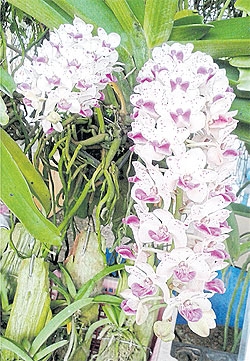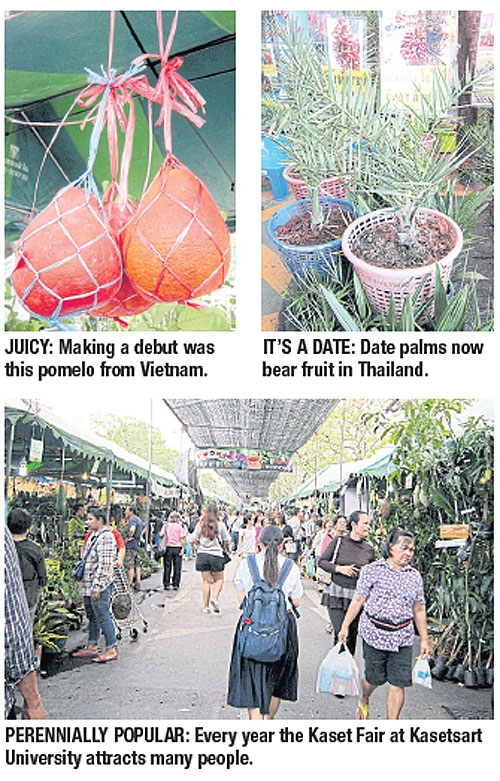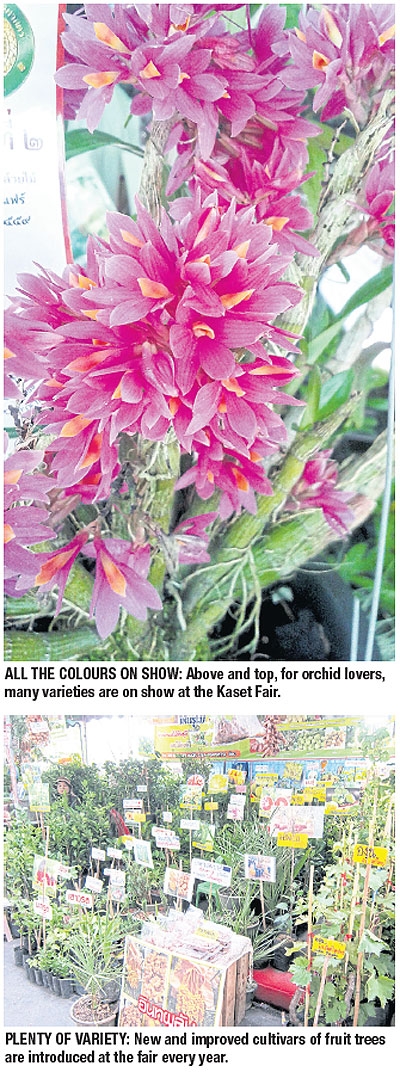As a regular visitor, I already knew what to expect at this year’s annual agricultural fair at Kasetsart University. There would be fruit tree saplings, ornamental plants and agricultural machinery for sale. There would be seasonal fruit and agricultural crops. Nearly half of the produce on sale, however, would be fried food, and things only remotely related to agriculture, such as furniture, footwear, accessories, clothing and cosmetics.
But I go every year anyway, because I like looking at orchids, and there are always new and improved cultivars of fruit trees introduced at the fair. In previous years these have included trees bearing fruit four or five times bigger than the old varieties; such as marian plum, or maprang; Indian gooseberry, or Emblica officinalis; mango and sapodilla. I have seen varieties of guava with maroon, juicy flesh; dwarf coconuts bearing 30 to 50 fruits per bunch; and plentiful giant lime trees, to name a few. Either the actual fruit or photos of it are shown, so buyers have an idea of what to expect from their purchases.
For fans of jackfruit, I’ve seen several cultivars, including one with fruit weighing as much as 30kg and containing thick and sweet orange or red pulp, instead of the usual yellow. Others had smaller fruit, but almost all parts were edible. Photographs showed trees with bunches of fruit from top to bottom of the trunk. However, if you have a jackfruit tree with as much fruit as this, make sure to remove some so the remaining ones can develop and grow big.
There were more of the same fruit trees, as well as many others, at this year’s event, which was held from Jan 30 to Feb 6. Making its debut was a bright red-orange pomelo said to have originated from Vietnam. It looked no different from the pomelos that Thais have been growing for years, except for its colourful skin and pulp. Like all newly introduced plants, the tree was rather expensive, with prices ranging from 500 baht for a sapling less than 30cm tall, to 1,500 for bigger specimens. A two-metre fruit-bearing tree was selling for 30,000 baht.

Cheaper at 150 baht for a 60cm grafted sapling was a variety of pomelo originally from Malaysia. The fruit is yellowish green when ripe, but the juicy pulp is dark red. Tastewise, however, I prefer the old cultivars grown in Nakhon Chai Si, Nakhon Pathom province, which are sweet and juicy.
Pomelos are all the same in their cultivation requirements. Like lime and any other citrus trees, they need full sun and grow best in well-drained soil with plenty of organic matter such as compost, leaf mould and decomposed animal manure. Water once a day until the plants are well established, after which you may water once or twice a week, or as needed.
Another fruit that made a splash at the fair was date palm, which Thais call intapalam. A grower was selling not just plants but also fruit from trees grown in big woven baskets in his nursery in Sam Phran, Nakhon Pathom province. Date palms are dioecious, which means that male and female flowers are produced on separate plants. Only the female plants bear fruit; they are wind pollinated, but in the Middle East where they originated, date palms are pollinated manually.
Date palms are best planted in the ground but they can also be grown in big containers like plastic wooden baskets, tubs, or concrete sewer pipes. They can be grown in any kind of soil but for best results use a mixture of three parts soil, three parts sand, three parts chopped coconut husk and one part decomposed animal manure.
While the trees are still small, apply a small amount of fertiliser high in nitrogen, such as NPK 25-7-7, every 15 days. Change to 16-16-16 when the plants are big and robust. Water generously after each application. Date palms usually take four to eight years to bear fruit, but the nursery owner claimed his trees took only three years. If you are growing several trees, plant or place them four to six metres part.
Meanwhile, if your adenium is not flowering well, a nursery owner recommends using a planting medium comprising equal amounts of soil, decomposed raintree (chamchuri) leaves, chopped coconut husk and decomposed animal manure. Make sure it gets full sun, and water just twice a week.
If you went to the fair but didn’t buy the plants that took your fancy because they were too expensive, wait another year or two and the price will go down. Indian gooseberry, which was selling for 300 baht last year, was priced at just 100 baht this year.
Email nthongtham@gmail.com.



